Technologies
What Apple’s ‘Wonderlust’ Event Invite Could Tell Us About the iPhone 15
Commentary: By examining the title and graphic for the next Apple event, we can speculate about what’s coming to the next iPhone.
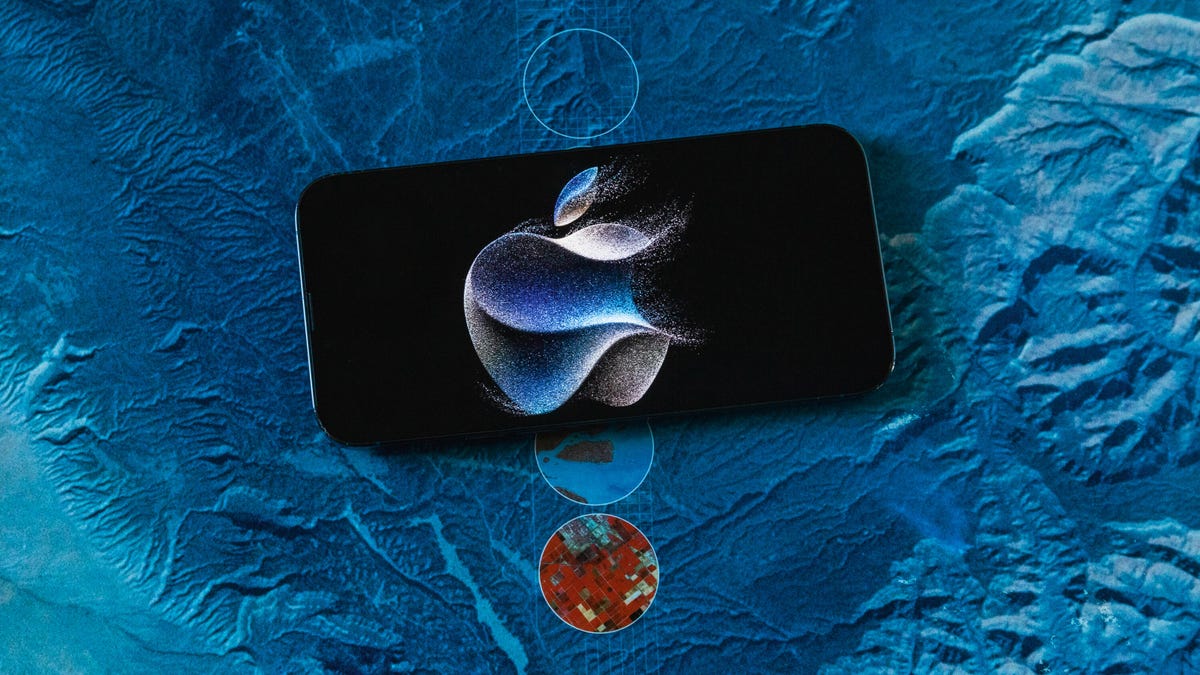
Apple’s «Wonderlust» event is set for Sept. 12, and the company’s invitation could be our first «official» clue hinting at the rumored iPhone 15. We’ve been collecting rumors about the gadget for months, but Apple sometimes drops an early hint about its September event into the invite. This doesn’t always mean there are true connections between what’s said and shown in the invitation and what actually emerges at the show, but the invite creates a jumping off point for discussing what we think Apple might spotlight.
See also
Examining Apple’s ‘Wonderlust’ invite
Let’s start by thinking about the name: Wonderlust. With this tweak of «wanderlust,» Apple appears to be invoking a travel theme. And it’s no stretch to say phones are essential travel companions: We use them for photography, GPS, looking up where we want to eat — there are endless possible features that could be developed with just travel in mind.
Moving onto the invitation’s design, we get a disintegrating graphic that shows a blue-and-sand-colored Apple logo being blown apart by an invisible force — perhaps the wind? Or perhaps the pieces of the Apple logo are being pulled together via a magnetic attraction? Either way, an atmospheric element might be what we could extrapolate from this design choice, and phones by their very nature are wireless devices that create constant connections through the atmosphere.
(It’s also true that blue and gray have been iPhone colors in the past, and maybe this logo’s colors provide an early look at what a few of the iPhone 15 models might look like.)
I should reiterate that these thoughts are speculation, but they’re enough to warrant a closer look at how Apple could improve the iPhone 15. The following things all tie into the themes of travel and atmosphere, but they’re also areas in which Apple could demonstrate improvement where rival phones have already staked out territory, or they’re realms closely related to iOS 17 features we already learned about at Apple’s WWDC event.
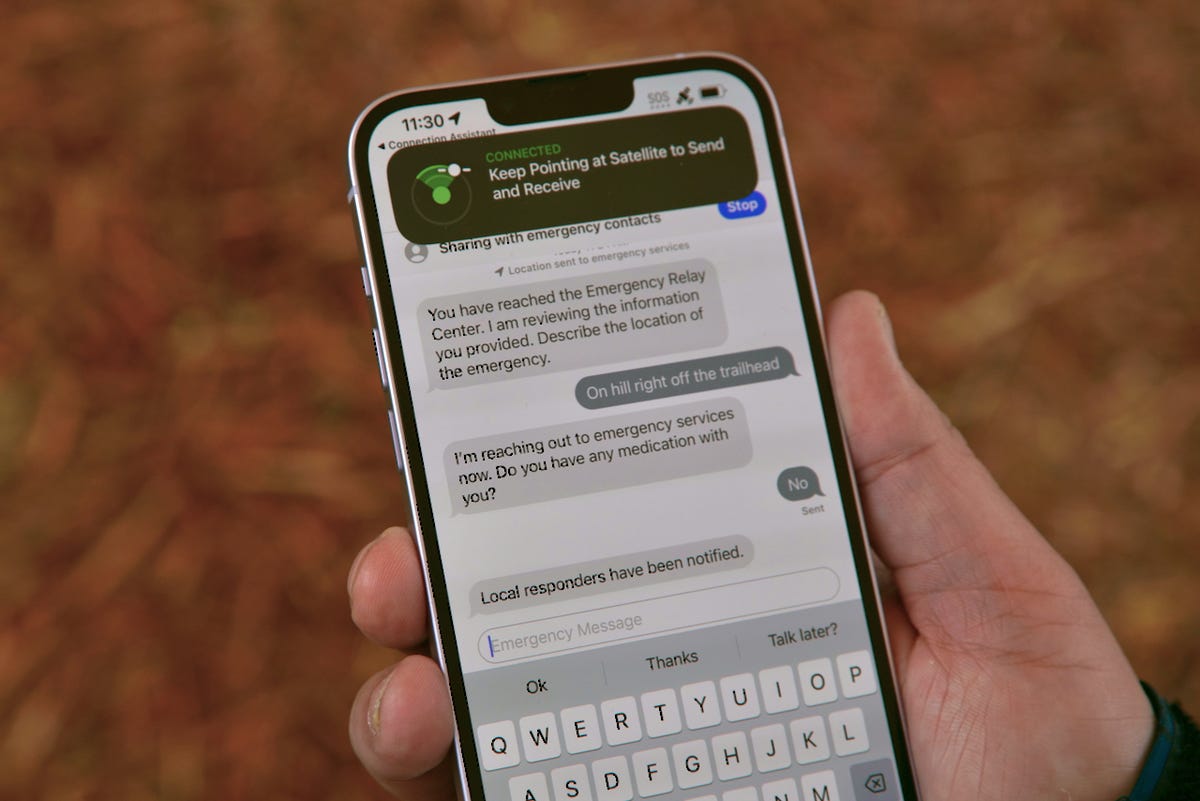
Even more satellite communication
Tying into both travel and the atmosphere, Apple could make new announcements related to the satellite connectivity features first launched with the iPhone 14 line. Right now Apple’s efforts are focused on its Emergency SOS feature, which lets people with a clear view of the sky use the iPhone to text emergency services where cellular service isn’t available. The iPhone 14 line comes with two years of free emergency satellite service.
Though Apple kicked off bringing satellite service to phones, it won’t be alone for long. Qualcomm, Samsung and other companies have announced plans to bring their own spin to satellite connectivity, including voicing their intention to allow for nonemergency communication over those airwaves.
On this year’s stage, Apple could announce new improvements to its satellite connectivity features, perhaps allowing for an iMessage service while in the wilderness, or limited voice calls.
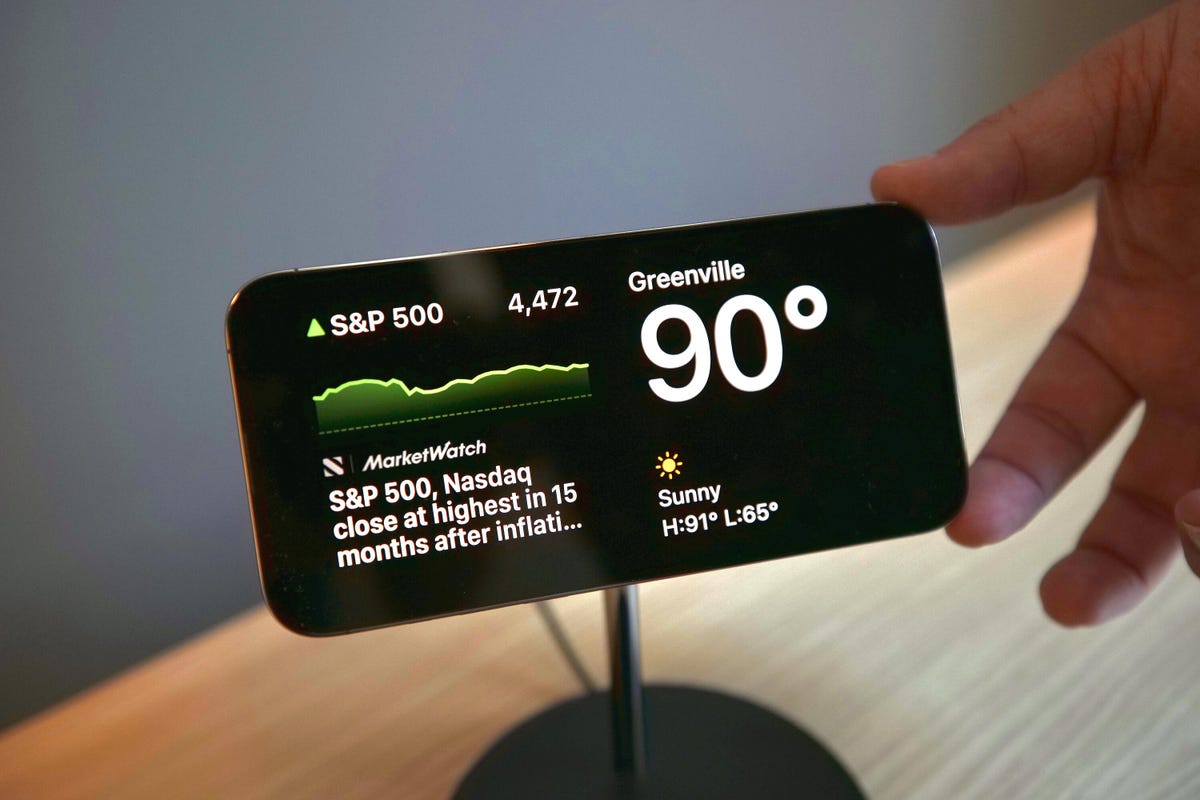
Faster wireless charging and more MagSafe
Apple’s MagSafe made a splash when it debuted alongside the iPhone 12 in 2020, very literally snapping separate objects together for enhanced wireless charging and stackable accessories. The particle effect in our Apple event invitation — whether it means the logo is being pulled together or apart — could indicate MagSafe as well as the wireless charging feature that MagSafe supports.
And if so, it’s about time. Apple has room to improve the iPhone’s wireless charging speeds, especially when compared with those of rival flagship Android phones. Currently, Apple supports 7.5-watt wireless charging speeds with a regular Qi wireless charger, and 15W speeds with an officially certified MagSafe charger. Meanwhile, Google’s Pixel 7 can wirelessly charge at 12W on a Qi charger with an extended power profile, and that bumps up to 20W when using Google’s Pixel Stand that has a built-in fan. Previous OnePlus phones can get 15W charging from Qi wireless chargers with an extended power profile, and a ludicrously fast 50W on their official stand, thanks to the use of a split battery. All this leaves a lot of room for growth for Apple, and matching Google’s speeds, at least, would be a solid step in making wireless charging more useful on the iPhone.
A new Qi2 wireless charging standard is in the works though, and Apple is a member of the Wireless Power Consortium that’s developing it. Whenever that standard is ready, that might lead to faster wireless charging speeds on future iPhone models.
Regardless of charging, there’s likely even more room to grow MagSafe into a modular accessory platform. Maybe Apple could create a MagSafe dock that instantly starts an AirPlay session with a TV. Or create an attachable projector like Motorola once tried with the Moto Z phone line. How about a portable HomePod speaker that snaps right onto your phone, similar to a number of magnetic speakers that already exist on Amazon? There’s still a lot of untapped potential for MagSafe.
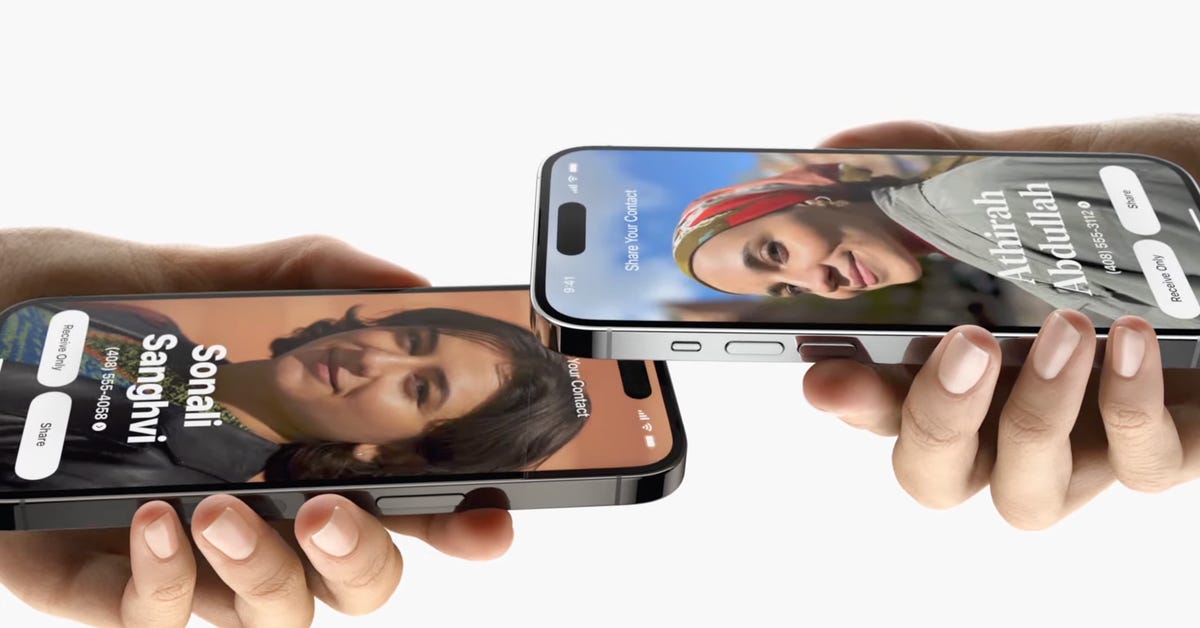
NameDrop and new ways to share in person
Another atmospheric idea starts with an iOS 17 feature we already know: NameDrop. This feature lets you quickly share contact information with someone in person by bringing two iPhones together. But Apple could do so much more with local wireless sharing.
For instance, Apple already allows for sharing iPhone audio between two different sets of AirPods. What if this wireless sharing expanded SharePlay, allowing for simultaneously playing music and video across multiple phones at once — without being on a FaceTime call.
This could be instantly useful if you wanted to share a YouTube video with a friend without having to hand over your phone. Or if you wanted to create a quick surround-sound system by syncing five iPhones together to play music during a dinner party, since your phones are probably sitting on the table anyway.
These all could be natural extensions of other features we already know are on the way. For instance, FaceTime on Apple TV will use its own wireless magic to connect an iPhone’s camera and microphone for video calls. Why not think even bigger and let multiple iPhones share even more media, just by being right next to each other?

Using your camera to scan even more places
Returning to travel, Apple’s Visual Look Up is already capable of identifying landmarks, plants and pets, but you need to move over to the Photos app to take advantage of those features. Perhaps the next iPhone and iOS 17 could speed this, and let you start scanning these items directly from the camera app.
This would bring Visual Look Up into better parity with Google Lens, which quickly identifies items for you without the need to save them into your camera roll. Maybe you could scan a restaurant while you were standing in front of it, and then get its menu. Or scan a friend’s shirt, and then find it on sale to get it yourself. These scenarios are already possible with Google Lens, making this a very noticeable way for Apple to bring more features into its camera app.

Expanding safety features
When you travel in a vehicle, Apple’s new Crash Detection features could provide an essential lifeline in the event of an accident. As it stands, the feature can automatically contact emergency services should a supported iPhone or Apple Watch detect such an event. But perhaps Apple could augment this further by taking advantage of other sensors within the iPhone or a paired up Apple Watch to activate a heart rate sensor at the same time to provide a quick health check to the wearer.
Or maybe Apple could expand its Crash Detection feature so it shares your physical location with your emergency contacts. This could be similar to Apple’s new Check-In feature, which will proactively send alerts when friends or family make it home safely. And maybe it’s already worthwhile to expand this feature for emergency situations, like being unexpectedly taken to the hospital.
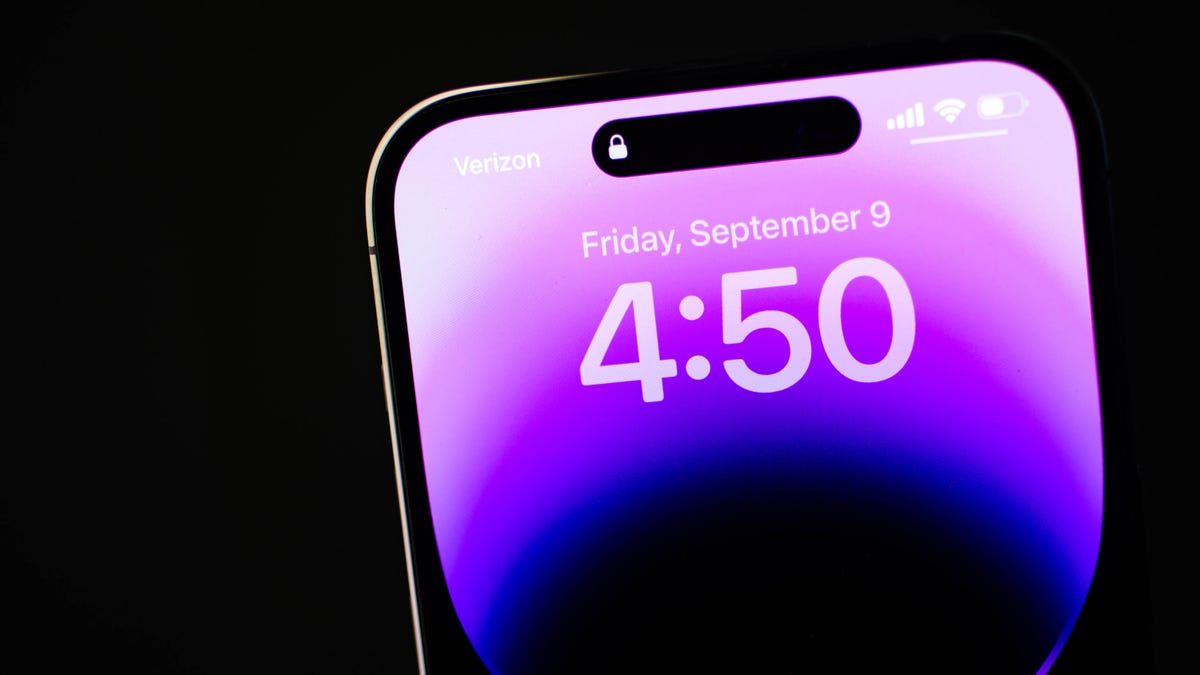
Other iPhone 15 rumors we’re watching
Though we don’t have any solid evidence that the above ideas are coming to the iPhone 15, these are all areas where Apple could improve.
The iPhone 15 rumor mill is a busy one though, and even without an invitation to pore over, we’re monitoring the possibility of a USB-C port arriving to replace Lightning, seeing if the new Dynamic Island will expand to every iPhone model after its debut on the iPhone 14 Pro, and wondering whether the iPhone 15 Pro will move toward solid-state volume and power buttons.
Whatever’s ultimately on the way to Apple’s iPhone 15, we’ll likely find out for sure when Apple’s event begins on Sept. 12.
Technologies
These Anker Earbuds Are Down to $57 — and Even Amazon Couldn’t Resist Matching the Price
Grab yourself a solid pair of earphones that offer excellent noise cancellation and battery life.

There are plenty of earbud options out there, but finding the right ones for you can feel nearly impossible as a result. But if you’re after some of the best noise-canceling wireless earbuds and you’d like to save some money, we might have the answer for you.
Best Buy is running a one-day sale on the excellent Anker Soundcore Liberty 4 NC earbuds, knocking the price to just $57 — which matches the lowest price we’ve seen yet. And Amazon’s price-matching. With a 43% discount, now’s the time to grab a pair before this limited-time deal disappears.
These earbuds have 11mm drivers, as well as hi-res wireless, LDAC technology and adaptive noise canceling that should reduce noise from your environment by up to 98.5%, according to Anker. That means you can stay immersed in the music (or other content you love) regardless of what’s going on around you.
Plus, because they’re equipped with six mics, they offer good call quality, regardless of your environment. We found them comfortable, too, and loved the bass they put out.
Hey, did you know? CNET Deals texts are free, easy and save you money.
The Liberty 4 NC earbuds have an impressive battery life as well, offering up to 10 hours of playback per charge, with an additional 50 hours available with the charging case. And just 10 minutes of fast charging can get you up to four hours of playback. They’re also rated IPX4 water-resistant, so any inclement weather while you’re out shouldn’t cause these buds any harm.
Another great feature these earbuds offer is multipoint connection, which lets you connect to your phone and your computer at once, which is super convenient. That’s a lot of features for earbuds this affordable.
If you’re not totally sold on this model, be sure to check out our roundup of all the best headphone and earbuds deals happening now.
HEADPHONE DEALS OF THE WEEK
-
$300 (save $51)
-
$299 (save $151)
-
$220 (save $180)
Why this deal matters
These excellent earbuds are now available at their record-low price. Best Buy is limiting this discount to a one-day sale, and we expect Amazon to end the deal around the same time, so be sure to grab a pair before this opportunity expires.
Join Our Daily Deals Text Group!
Get hand-picked deals from CNET shopping experts straight to your phone.
By signing up, you confirm you are 16+ and agree to receive recurring marketing messages at the phone number provided. Consent is not a condition of purchase. Reply STOP to unsubscribe. Msg & data rates may apply. View our Privacy Policy and Terms of Use.
Technologies
The Apple Watch Ultra 3 Just Got Its First Proper Discount, but It Won’t Last Long
The latest rugged smartwatch from Apple is yours for just $700 right now.

The Apple Watch Ultra 3 has only been on sale for a few weeks, but it’s already available for its first real discount. Getting one of the best smartwatches money can buy isn’t going to be cheap, but this deal saves you $99 off the usual asking price. But be warned, we don’t expect this early Black Friday deal to last long.
The result? You’ll pay just $700 for your new Apple Watch Ultra 3, with a couple of colors and band combinations available. These prices often fluctuate, so we suggest checking out all available pairings before placing your order. Apple Watch Ultra 3 deals are likely to come and go quickly.
All Apple Watch Ultra 3 models come with cellular modems inside so you can connect them to your carrier — assuming it supports the Apple Watch’s eSIM. That’ll allow you to stay connected even when you don’t have your iPhone with you.
Hey, did you know? CNET Deals texts are free, easy and save you money.
The Apple Watch Ultra 3 comes in a large 49mm size, so it’s easy to read. Despite that huge display, Apple Watch Ultra 3 owners can expect long-lasting battery life. In fact, the Apple Watch Ultra 3 can run for up to 42 hours in normal mode and a whopping 72 hours in its low-power mode.
This being an Apple Watch, it comes with all of the usual health and fitness monitoring features, as well as sleep tracking. It can monitor your heart rate, track your progress thanks to its precise dual-frequency GPS, and do a whole lot more.
If the standard Apple Watch models can’t quite live up to your busy, active lifestyle, this is the model for you. Be sure to order your new smartwatch before this deal expires.
SMARTWATCH DEALS OF THE WEEK
-
$329 (save $100)
-
$200 (save $100)
-
$200 (save $100)
-
$500 (save $150)
Why this deal matters
The latest Apple Watch Ultra 3 is the best of its kind. It has a new display that’s designed to be easier to read and has an impressive battery life. It isn’t the cheapest smartwatch on the market, but if you want the best that Apple has to offer, now is the time to place your order — before this deal ends.
Looking for savings on other models? Check out all the best Apple Watch deals happening now.
Join Our Daily Deals Text Group!
Get hand-picked deals from CNET shopping experts straight to your phone.
By signing up, you confirm you are 16+ and agree to receive recurring marketing messages at the phone number provided. Consent is not a condition of purchase. Reply STOP to unsubscribe. Msg & data rates may apply. View our Privacy Policy and Terms of Use.
Technologies
Here’s the Best Time to Spot November’s Supermoon, the Brightest Moon of 2025
Does the moon look brighter and bigger? It’s not just you — here’s why this month’s supermoon is even more super.

November is a great month for skygazers, featuring a trio of meteor showers and the return of the northern hemisphere winter constellations. This week, it also features the second of four consecutive supermoons. This month’s supermoon will happen on Nov. 4-5, and November’s beaver moon is special because it’ll be the brightest full moon of 2025.
Don’t miss any of our unbiased tech content and lab-based reviews. Add CNET as a preferred Google source.
In addition to being a supermoon, November’s full moon is known as the beaver moon. There is some debate as to why it was named this way. Some believe that this was the best time of year in the old days to set beaver traps to get pelts for winter clothing. Others believe that it coincides with the busiest part of the year for beavers, who are now stocking their lodges with supplies for the upcoming winter.
The brightest supermoon: When’s the best time to see it?
The moon will reach peak illumination at 8:19 a.m. ET on Nov. 5, making the evening of Nov. 4 and the morning of Nov. 5 the best times to view the moon.
Since moon phases shift slowly, the moon will appear almost full for nearly a week. If you are unable to view the full moon on its best night due to weather or other reasons, you can still see a mostly full moon at any point from Nov. 3 to Nov. 8.
For all of those days, the moon will be measurably brighter in the night sky compared to any other full moon in 2025. The reason for this is because of the moon’s elliptical orbit. Since it’s not a perfect circle, the moon’s 27.3-day journey around the Earth brings it closer to us on some days, a phenomenon known as perigee. If there is a full moon during this time, it’s branded as a «perigean full moon,» which you may know better as a supermoon.
Not all supermoons are equal, and November’s will be a little more special than others. According to The Farmer’s Almanac, the beaver moon will be a scant 221,817 miles away from Earth, making it the closest full moon of the year. That means it’ll be the biggest and brightest of the year.
In practice, the differences are fairly minor and likely won’t be visible to the naked eye when compared side by side to other supermoons. A supermoon is only about 7% larger than a regular full moon. According to NASA, the biggest difference is when comparing a supermoon to a micromoon, where a supermoon will be about 14% larger and 30% brighter. So, if you notice that your backyard patio is lit up more than usual, it’s because of the supermoon.
Also due to the moon’s orbit, November will also bring a micro new moon, which means the moon will be as far away from the Earth as it can get — a phenomenon known as apogee. November’s new moon occurs on Nov. 20, but you won’t be able to see it.
-

 Technologies3 года ago
Technologies3 года agoTech Companies Need to Be Held Accountable for Security, Experts Say
-

 Technologies3 года ago
Technologies3 года agoBest Handheld Game Console in 2023
-

 Technologies3 года ago
Technologies3 года agoTighten Up Your VR Game With the Best Head Straps for Quest 2
-

 Technologies4 года ago
Technologies4 года agoVerum, Wickr and Threema: next generation secured messengers
-

 Technologies4 года ago
Technologies4 года agoBlack Friday 2021: The best deals on TVs, headphones, kitchenware, and more
-

 Technologies4 года ago
Technologies4 года agoGoogle to require vaccinations as Silicon Valley rethinks return-to-office policies
-

 Technologies4 года ago
Technologies4 года agoOlivia Harlan Dekker for Verum Messenger
-

 Technologies4 года ago
Technologies4 года agoiPhone 13 event: How to watch Apple’s big announcement tomorrow
